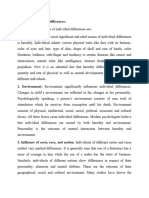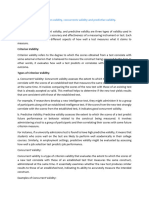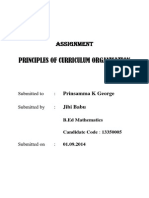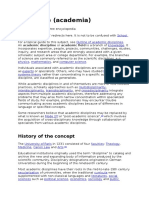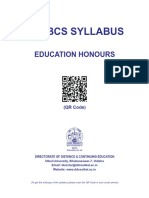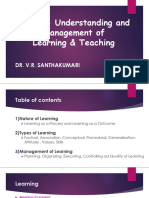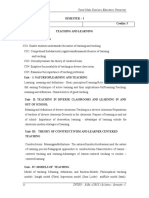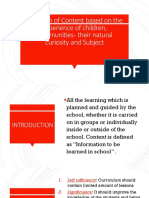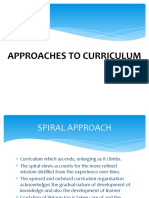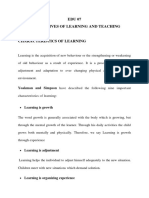0 ratings0% found this document useful (0 votes)
1K views10 pagesIndividual Differences (Unit - 3)
Uploaded by
Rahul ChaturvediCopyright
© © All Rights Reserved
We take content rights seriously. If you suspect this is your content, claim it here.
Available Formats
Download as PDF or read online on Scribd
0 ratings0% found this document useful (0 votes)
1K views10 pagesIndividual Differences (Unit - 3)
Uploaded by
Rahul ChaturvediCopyright
© © All Rights Reserved
We take content rights seriously. If you suspect this is your content, claim it here.
Available Formats
Download as PDF or read online on Scribd
You are on page 1/ 10
Individual Differences : Meaning, =
od re,
Areas, Causes, Influence on Learning and
Educational Implications
Meaning and Nature of Individual Differences
All persons in the world are not equal though the physical constitution of
almost similar. All persons have two hands, two legs, two eyes, two
etc, But the similarity of body organs does not make ail persons
Every person is different from another. Even the twins of same
lar; there is difference in their behaviour, intelligence, etc. Thus
s which distinguish him from others, Thi
individual differences. This difference can
social or emotional vie points In the modem. —
fferences has so influenced education that
education has become almost impossible without it. It is not agreed that every child
should be educated according to his needs, characteristics and feelings. Some of
the important definitions of individual differences are as follows :
“A knowledge of the nature of individual differences is essential, if the
teacher is to improve the education that all children receive regardless of their
ability. —Skinner
gil persons i
ays and a nos
similar OF equal.
parents are not simi
every person has his own characteri
difference found in a person 1s Cal
te from physical, mental, motor,
times, the theory of individual di
of the group, with respect 0
idual member of the group. .
—James Drever
the variations of deviations: among
characteristics.
—C.V. Go
“Variations or deviations from the average ¢
in the indivi
the mental or physical characters, occuring in
“Individual differences stand for
“i i non
“viduals in regard t0 a single characteristic or @ number Ol
physical size and
nent an
—T)
shown to exist in ;
achieve!
ryler
shay, “Measurable differences have been SION" gence,
dpe, physi 7 . o¢ ities, intelligence
Physiological functions, motor capactte®
MOwledos acne”
'wledge, interest, attitude and personality 1 ails.
86
ment
Childhood and Growing y
Ip
Characteristics of Individual Differences
~Poychologists. aller their profound study of individual differences, hy
syehe a have
v1 acterisics +
San the foopte are uniform in the world,
; fe traits are uniform In any (wo individuals. /
‘All individuals vary in physical strength and rate of maturation,
_ All traits are related to each other in some manner.
~The capability to learn varies in children ce same age even,
"individual differences are a multidimensional concept, and are influenoeg
by both heredity and environment. :
7, Individual differences can be expkained on the basis of those traits which
can be measured.
Different traits of an individual influence others.
. There is variation in the amount of different traits in the same individual,
‘An individual can be near the average score from the view of a particular
trait, while he can be lower or higher in respect of other traits.
10. The curve of a trait in individuals of a group is towards its mean,
11. Individual differences form the basis of different types of development of
an individual.
‘The basis of individual differences can help to bring about adequate
development of an individual.
i Areas of Individual Differences
Personality of an individual is the mixture of several traits. He inherits
Auewy
wn
5
several traits from his forefathers; he also acquires several traits from his
envi
and
the
his
jronment. In fact, personality of an individual is the product of his heredity
social heritage. It is on the basis of these traits that we can find differences in
personality of different individuals. These personality traits are related with
physical, mental, emotional and social domains, and he undergoes varied ratio
of development in these domains. Therefore, these domains are accepted as fields
of ii
individual differences, which can be delineated as under :
1. Domain of Physical Differences : It comprises the following fields:
(a) Physical differences.
(b) Motor ability differences.
2. Donan of Mental or Intellectual Differences : It comprises the follovi"s
‘elds :
(a) Intelligence differences,
(b) Achievement differences,
(c) Aptitude difterenc
(d) Special abili
differences.
3. Domain of Emotional Di ing fields *
mn al Differences : paee fiel
(a) Emotional differences. ces # Tt comprises the folotNB
divi Differences « Meaning, Nature, Areas, Causes, Influence on 87
—“(h) Aptitude differe
(c) Attitude differences,
4, Domain of Social Differences
(a) Differences in social traits
(b) Differences in cultural tr:
(c) Differences in ideals, values and morality.
(d) Differences in racial and national field,
Types of Individual rey,
'y. People possess
+ It comprises the following fields :
There are no two uniform or equal individuals in the societ
giverse differences, as :
1. Differences related to physical growth and development.
2. Differences related to mental development.
3. Differences related to motor development.
4. Differences related to emotional development.
5. Differences related to social development.
6. Differences related to linguistic development.
7
8.
Differences related to moral and character development.
Differences related to aesthetics and aesthetic development.
9. Differences related to interests and hobbies.
10. Differences related to attitudes.
Il. Differences related to aptitude.
12. Differences related to thinking and assumptions.
13. Differences related to specific abilities.
14, Differences related to values and ideals.
15. Differences related to aspiration levels.
16. Differences related to learning capability.
17. Differences related to achievement.
18, Differences related to 1.Q.
19. Differences related to study habits.
20. Differences related to personality. /
In addition to the above differences, some more differences are found in
children; the more important of individual differences are as follows : ;
1. Differences at Intellectual Level : All persons do not have similar
'nlellect, some are gifted and others backward. On the basis of intelligence tests
Wecan find out whether a child is genius, very superior, normal, dull or idiot.
2. Differences in Physical Development : Physical development i a
sons is not uniform. Some persons are fat, some thin, some tall, some iat
Some fair, some dark, some attractive, some ugly, some strong, some weak am
Petsons have difference from physical viewpoint. Physical differences a from
birth itself, for example, having six fingers, flat or long nose, large lips,
ot
Childhood and Growing U,
Ip
Betting
uired 100,
Sometimes
mouth defor
3. Em
types of emotions.
med, ete
otional Diffel
pme pe
es ¢ Different persons or children develop differen
ons are always happy. some dejected, some invitabie
, some emotional, some emotional},
y
come peaceful, some
some angry. some peaceful, :
poral fame have normal behaviour, etc, They may have tense behaviour ang
restlessness.
Ability : We can differences 1n different person as
4. Differences in Motor-.
as their motor a bility is concern
ask immediately and s|
ed. Some develop it fast and some late. Some
killfully while other children of their age can’t
far
children do at
do it
5, Differences in Interest : Generally the interests of all persons are different
from one another, some have interest in reading, some in playing. Some have interest
in good clothes, some in good clothes, some in music, some in films. The factors
such as family background and level of development influence the interests of
children.
6. Differences it
difference is seen not only among childre1
same age groups. Some children are very sl
same thing belatedly.
7. Differences in Speci
the field of specific abilities
mathematics or Hindi. Some c!
persons do not have specific abilitie:
example, all players don’t have the same standard.
8. Social Differences : Differences are found in boys and girls in their social
development. Some children become socially mature soon and some late. There is
difference in the children from social traits viewpoint too. Some children have
leadership qualities while some children like to follow. Some are extrovert and
some are introvert. Some are skillful at quarrelling while others at befriending.
~ Causes of Individual Differences
1 The following are the chief causes of individual differences :
aan Influence of Heredity : According to psychologists McDougall, Pearsot.
an i eredity is the chief cause of individual differences. A person gets his
not SE xion, etc. from heredity. The parental seed has its influe
reais are sharp + but also-on his mental traits, Often, the children of SU
begin fe pea of dul Parents, dull. According to Munn, the life of all peop. ;
h ne dity, Heredi a en What is the cause of it being different? It is due to iffere
eredity. Heredity has its influence on the person, but it would be @ fallacy !°
in Learning : Differences can be seen in their learning. This
n of different age groups but also of the
killful at learning while others leam the
fic Abilities : Differences can be seen in persons in
Some children are good at English, some in
Idren are good at reading, some in writing. All
s and there is difference in the amount, for
r
pavidual Differences Meaning, Nature, Areas, Causes, Influence on... __ 89
ef] only heredity is the se of individual differences. If it were so, the children
of the same parents would not be different.
o
Influence of Environment + Environment also has influence on individual
differences Environment is of two types : (a) natur:
gnvironment, THE people in the warm climate aré dark, Ta
aie in the cold climate are fair,
a laborious and
gqvironment also has its influence. A person has his lifestyle, conduct and behaviour
according tO the st ciety that he lives in, If a child from Hindi belt goes to live
Smnong Sindhis, Tamils or Bengalis, his lifestyle, language too changes accordingly.
Thus, the neighbourhood brings individual differences in the child.
3. Influence of Race and Nationality : Individual differences depend on
racial and national basis also. A person has the characteristics of the race and nation
in which is he born. A child born in a Brahman or Kshatriya family has inclination
for studies and martial activities. The traits that a Hindu child begets, are different
from those of a Muslim or Christian child. In the same way, difference found in
the conduct, nature, interest, physical and mental condition and personality is due
to the difference in the country.
4, Influence of Economic Condition and Education : Individual differences
‘are also found due to economic condition. and education. Parents’ economic
condition, lifestyle, occupation and education has deep impact on the children.
The personality development of the rich, high lifestyle and educational families is
good, while those of poor, illiterate families is not and they are unable to learn
good habits. As a result, differences in found them though intelligence is same in
them.
5, Influence of Sex : Physical and mental differences are found in boys and.
girls, Girls attain maturity one or two years prior to boys. The girls are soft, kind,
affectionate, shy and peaceful, while the boys are harsh, courageot ery, clever,
brave and skillful. The boys have more capacity for physical work, arithmetical ~
ability and intensity of imaginations, while the girls are better in memory, art
abilities and domestic tasks.
2 influence of Individual Differences on Learning
Learning is a continuous, extensive and lifelong process. Learning is not
a mechanical, but a rational process. A thing can be learnt quickly and easily which
's understood by the use of intelligence. It is necessary for an individual to be
active to leam, An individual can learn something when he takes part in the learning
Process actively, Learning is influenced by several factors, and from the viewpoint
Of these factors, children are different from one another, The differences received
from heredity and environment certainly influence a child's learning. The different
fields of individual differences that influence learning are as follows :
_ dudiffluence of Physical Differences on Learning : No two children are
alike in physical abilities. A child whose senses of perception and action does not
Qa
Childhood and Gr
Owing y,
Ip
a normal A
rn, nor does hep,”
at a slower rate a compareg Sess
With,
90
york well oF Hates
work jly or physically unhe Inhy ce
ae Hi Tear; as a consequence
y 0 \
z
=
cap.
pormal children.
2m 7
comprise inte
abilities Comp! Higenees
children are different from each oth
talented, while others are normal or
jateltigence, they learn more quickly
neces of Mental A ‘
asoning, thinking, logic, problem-solvin
er from mental viewpoint. Some chi
on Learning ;
+ Menta
Bete, 4)
i dren
kward. Talented children possess a yh
an normal or backward children, ang q"?
e of Differe!
Hligence, re
san retain it for a longer duration too. A child of normal intelligence leams uicke,
see gne higher are the mental abilities like thinking, learning ge
imagination, problem-solving etc. in a child, the quicker he learns.
Interest, aptitude and motivation too influence learning. Psychologists have
explained that interest and aptitude are related See eee Pager and are
helpful in each other's development. A child learns those subjects and activites
quickly in which he has interest, and can retain it for a longer duration. Lack of
interest even negatively influences the learning of a talented child. Aptitude is an
innate ability, which is cultivated by environment, teaching and training. A chilg
can succeed in a field in which he has aptitude. Even a sharp child cannot be made
a doctor, engineer, scientist or poet or artist if he does not possess aptitude in it,
Motivation too influences learning greatly. If two children possess equal amount
of interest, aptitude and intelligence, of them a motivated child will perform better
in learning, because motivation makes him active by developing his emotional and
motor abilities.
_3Ainfluence of Emotional Differences on Learning : The third field of
individual differences pertains to emotional differences: Different children cultivate
different emotions differently. Some children peeve in no time while others are
patient. Some children grow anxious and sad in no time, while others are courageous
and remain happy all the time. All this has influence on their learning. There are
some emotions which always contribute to a child’s learning, as creative tendency,
entertainment, light-heartedness, sense of command, self-pride etc.; and there are
some emotions which hinder learning, as anger, hunger, suffering, hatred and the
like. There are some emotions which are helpful in learning in one situation, but
not in other, as fear and surprise. Thus, we can see that emotional differences
influence a child’s learning.
, ax Influence of Social Differences on Learning : Social environment 10°
introduces differences in learning. When children study in the same environment
they are able to adjust with one another; and take part in the learning proce
Joyfully; however, when children coming from diverse environments study together
they face difficulty in adjustment, which negatively influences their learning.
____ Inaddition to the above differences, there are differences in achievem™
attitude, personality, specific abilities, self-concepts, ideals, values, principles:
(Fumpeveetnesasreeeyesnsenstetenpensctimnstienpsgeciseesssuyenssieasenpietianafbateapemasingatneceetalaeasaeney apn .
ve in others. There
sitive hildren @ . . Therefore, a teacher is duty-
por gto keeP children away from negative influences and motive eran!
tive influences as much as can be possible. otivate them to apply
gducetional Implications of Individual Differences
_/- The individual differences of the chidren have i ace i
gusto Modern panels has proved that every child eee eee
cs is capacities, abilities, powers and interes, So thei education
uty ne conducted Keeping in view their abilities. The following factors should
aavocin view while aanging education for children: :
{, Classification : Different students of a class have physical, mental
ena an socal differences besides differences in age. So, iis not proper to
savy them according to traditional method. They should be classified on the
of mental differences into homogeneous groups. Each class ean be divided
wey vee groups : superior, normal and dull children. Besides intelligence,
polosical age, emotional attitude, social maturity and interest should also be
sudattention while classifying. :
"A, Size of the Class t If the number of students is more in the class, t becomes
difficult for the teacher to manage their educational needs according to their
inlnidual differences. So, the size of the class should be stall According to Ross,
the number of children under each teacher should be so small as he can individually
leow them, without it he may ask such children for such activities which are
impossible for them to do.
3 Curriculum : Curriculum should be constructed according to individual
differences, Prescribing common curriculum for all children would amount to
discouraging dull children who will lag behind further, while a genius child would
not get his mental satisfaction. So the curriculum should be flexible which can be
changed ac to the interests of the children, and it should comprise of such subjects
from which a child can choose according to his desire.
— 4 Teaching Methods : Teaching methods should be used according to
individual differences. A superior child Jearns faster than a dull child, so there
should be a difference in the teaching method utilised for them, In the present
tins, several individual teaching methods have been propounded. The Dalton ae
fe method, Winnetka plan, ete. are the teaching methods which keep individua
ferences in view while teaching.
wing Home Assignment : The children should be given homework ar
ing ‘ individual differences. It is not justified to give assignment ea com om
ating spare time for the superior children while the dull childre :
i st in view
ce children, Besides, the family circumstances should also be kept!”
le giving homework.
occupations on the basis of
the occupation that they are worth for.
Childhood and Growing y,
Ip
Education should be arranged on the basis o
Differences an. The audio-viswally impaired children sh
nces of the chile iy weak children should not be given ra
eat in the front, The phy
* ea nd a endicapped children should be treated sympathetically.
work and f
7. Sex Differences + There are differences in boys and girls from physica,
Se Tere onal viewpoints. They are different in interest, tasks ang
ation should be arranged according to sex difference. The scholar,
of them can be taught the similar subjects, but there
termediate cl
al Differences
mental, social
needs. So, educ:
say in this regard that both
should be a difference in i .
8. Vocational Guidance + Individual differences have special significance
in vocational selection. Different occupations require different physical, mental
tis the duty of the teacher to help the students choose
f their individual differences. The students should get
and personality traits. So if
Thus, we can see that the teacher can benefit the students by knowing about
their individual differences.
Teaching Techniques based on Individual Differences
The teaching provided in the school should be based on individual
differences due to its emphasis in educational field. The following methods and
techniques can be used while imparting individual teaching =
. Decroley plan
2. Contract plan
3. Activity method
4. Winnetka plan
5.
6,
. Dalton plan
. Project method
7. Programmed instruction
1. Decroley Plan : This plan was propounded by Dr. Ovel Decroley. This
method provides the child an opportunity to do concrete and abstract works (0
Soe self-illumination. This plan is based on the educational maxim ‘for
their ea td huer this plan, the students of the class are divided according ©
peieey i on capacity and ability, and a natural environment is created in
the els and emphasis given on informa conduct. The student i provided a
y for expression according to his capacity in the natural environment
Mayer has mentioned the follow
(a) Children have different intere:
(b) The child is a living being, It is
() The child can be educated for fj
(d) As the child grows, he changes.
(¢) Differences are found in the children of the same age
ing principles of the Decroley plan:
in different age groups.
necessary to prepare him for soci
fe, by life.
al life.
3, Cont
act Plan : In the contract pla
plan the conte: 5
ml ontent is specified, The children
fier the completion of the specifi
insta the com of the specified cont i i
ee child is leeging behind. Then attention aaa is hi Gackwattons
wn be suid that this plan remedies the shortcomings of the chil ae
soiled in the previous knowledge before impartin pete
imparting new knowledge.
o
oti ethod : By activi
3 activity M 'y activity method is meat
a : it
arding t0 Ri ‘hard Sapharth, activity method is based aCe
gccordite
si eas Been proved to be the best method for teaching,
Under this method, activity is considered to be the chief basis and all
jsare taught on the basis of activity, The chi i
cbjects are taught on y. The children enjoy freedom i
orsinity. The plan is made for six mont eee
after having selected the activity. Thi
, s s . This
scivity iS got done by the students. Under it, the students are free fro the selection
af activity (0 its execution and result.
When should the activity method be used? Sohoenchen has written : “The
cctivity method is applied when any form of activity is undertaken by the children
arher the ends of instruction in any subject.”
Pestalozzi has written that this method is based on psychological principle
that the activity of a child influences consciousness at three levels : thinking,
decision-making and interest.
4, Winnetika Plan : This plan was propounded by Dr. Karlten Washxumn.
Risk has written about it: “The Winnetka plan of indi idualised instruction is
probably more widely known than any other of its kind.”
According to William Byed, the following are the chief principles of the
Winnetka plan :
(a) Achild should live life in a natural, joyful and complete way.
(b) The progress of each person depends on his development of complete
capacity.
(c) Every child should gain complete mastery over useful facts
life. :
(W) Strong social consciousness should be developed in every person for social
welfare,
and skills in
Under this plan, the specified task is divided into small units. The aids
amined at the end of each unit and bis errors art mle out, The next Wi
Commences only after the previous has been Tectified. This plan encouras
‘tld to follow the principle for self-education. vl
’, S.Dalton Plan : This important plan was constructed fa Daa)
‘tkhurst. Elaborating the meaning of this plan she said : “Zhe Dal
_,
*hildh rowii
ot Childhood and Growing yp
plan is not a system or a method. It is a way of educational reorganisation Which
eo twin activities of teaching and learning.
ntred, so it provides opportunity to the chil
es ity. ILallows him to work p
accepting his individual differences. The Dalton plan is an important methog of
individual teaching. The teacher functions as a guide only. The child who. completes
his task before the specified time, has full opportunity to progress.
6. Project Method : The project method was constructed by Kilpatrick. This
method accepts individual differences and provides opportunity to each child to
work according to his capacity by which the child receives practical knowledge,
Yokam and Simpson have clarified the meaning of project by saying that it is g
large unit of natural and lifelike task being done in the natural environment, under
which attempt is made to do a work or remedy a problem. This task is very
purposeful and the completeness of the task is included. This task can be physical,
mental and social or only fully mental. For example, making a house for a dol]
and decorating it, a work done by hand or writing or acting in a drama, ete. it
includes several types of a ies which can be completed using any type of
materials. In the words of Kilpatrick : “A project is a whole-hearted purposeful
activity proceeding in a social environment.”
reconciles th
This method is child-
according to his intelligence and cap
pe
|
The project method provides practical knowledge to the student because
his own experience forms the basis of knowledge. According to Ryburn, this
method provides the child a new outlook and attempts to impart education with a
new method. The following steps are followed under the project method :
(a) Creating the situation
(b) Choosing the project
(c) Planning the project
(d) Carrying out the project
(e) Evaluating the project
(£) Recording the project
__ 7. Programmed Instruction : The programmed instruction is a new method
being used in the field of learning. Through this method, the children have the
opportunity for learning according to their individual differences. The curriculum
based on this method is divided into elements and is presented in small steps. The
students have to make expected responses after studying these steps and the students
themselves have to verify the responses. Thus, the child remains ready always int
such study and he also comprehends his knowledge. This method is helpful ia
providing new knowledge, keep them ready in the direction of learning and provide
stimulus to them. Thus, it can be said that this is such a psychological method in
which the child gets the opportunity to learn by himself.
Elaborating the meaning of programmed instruction, Susan Markle has
written : “Programmed instruction is a method of designing a reproducible
You might also like
- BCC 2 Contemporary India and Education, Concept and Process of Education.No ratings yetBCC 2 Contemporary India and Education, Concept and Process of Education.18 pages
- Q.1 Write A Note On Criterion Validity, Concurrents Validity and Predictive ValidityNo ratings yetQ.1 Write A Note On Criterion Validity, Concurrents Validity and Predictive Validity9 pages
- Knowledge and Curriculum Study MaterialNo ratings yetKnowledge and Curriculum Study Material180 pages
- Q.1 Explain The Concept Nature and Scope of Psychology. How Does An Educational Psychology Help The Teacher For Effective Teaching? What Is Educational Psychology?No ratings yetQ.1 Explain The Concept Nature and Scope of Psychology. How Does An Educational Psychology Help The Teacher For Effective Teaching? What Is Educational Psychology?26 pages
- Discipline (Academia) : History of The ConceptNo ratings yetDiscipline (Academia) : History of The Concept3 pages
- Unit I Educational Psychology and Development of The LearnerNo ratings yetUnit I Educational Psychology and Development of The Learner16 pages
- Role of Education To Understand The Social Diversity in India PDFNo ratings yetRole of Education To Understand The Social Diversity in India PDF4 pages
- Top 6 Methods of Educational PsychologyNo ratings yetTop 6 Methods of Educational Psychology13 pages
- Inclusive Education B.ed. Semester - 1 C.no. 105No ratings yetInclusive Education B.ed. Semester - 1 C.no. 105238 pages
- HCC-01 Historical Perspective of EducationNo ratings yetHCC-01 Historical Perspective of Education225 pages
- Construction and Standardization of Achievement in HindiNo ratings yetConstruction and Standardization of Achievement in Hindi8 pages
- Tamil Nadu Teachers Education UniversityNo ratings yetTamil Nadu Teachers Education University3 pages
- Psychology Presentation:: 1. Meaning of Transfer of LearningNo ratings yetPsychology Presentation:: 1. Meaning of Transfer of Learning9 pages
- Adjustment: Dr.P. Marishkumar, Associate ProfessorNo ratings yetAdjustment: Dr.P. Marishkumar, Associate Professor13 pages
- Methods of Studying Child Behaviour-Observation MethodNo ratings yetMethods of Studying Child Behaviour-Observation Method9 pages
- Universalisation of Elementary EducationNo ratings yetUniversalisation of Elementary Education3 pages
- Summarize The Advantages and Disadvantages of IQ TNo ratings yetSummarize The Advantages and Disadvantages of IQ T3 pages

